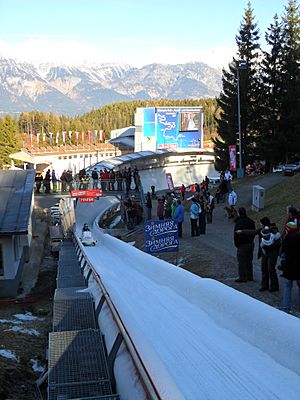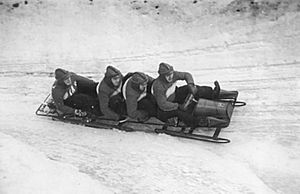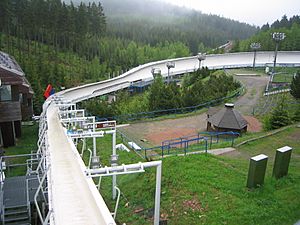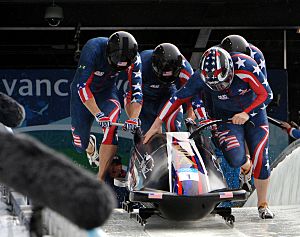Bobsleigh facts for kids
Bobsled, also called bobsleigh, is an exciting winter sport where teams race down icy tracks in a special sled. It's a popular event at the Winter Olympic Games. The tracks today are usually made of concrete covered with a thick layer of ice. You can also find tracks that are made artificially.
The main group that organizes international bobsled races is called the International Bobsleigh and Skeleton Federation (FIBT).
Contents
History of Bobsledding
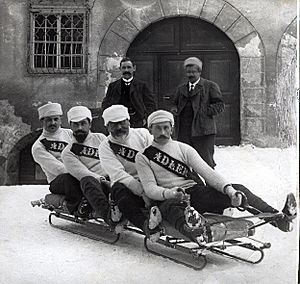
People have enjoyed sledding on snow and ice for a long time. However, bobsledding as a modern sport started more recently. It began when two smaller sleds, called skeleton sleds, were joined together with a board. A steering system was added to the front sled.
The sport got its start thanks to a hotel owner named Caspar Badrutt in St. Moritz, Switzerland. He convinced English tourists to stay in his hotel during the winter. In the 1870s, some of his adventurous guests started using delivery sleds for fun. They would speed down the village streets, sometimes bumping into people!
The name "bobsled" came about because competitors would "bob" back and forth inside the sled. This helped them go faster.
To keep everyone safe, Badrutt built a special track for these activities around 1870. This was the world's first natural ice track. It's still used today and has even hosted two Winter Olympic Games. It's special because it doesn't use artificial cooling; it relies on natural weather.
The first informal races happened on snowy roads. Official competitions began in 1884 in St. Moritz. The first bobsled club was formed in 1897. A track built just for bobsleds opened in 1902 near St. Moritz. Over time, bobsleigh tracks changed from straight runs to twisting, turning courses. The original wooden sleds were replaced by sleek sleds made of fiberglass and metal.
The International Bobsleigh and Skeleton Federation (FIBT) was officially started in 1923. Men's four-man bobsleigh was part of the very first Winter Olympics in 1924. The men's two-man event was added in 1932. Bobsledding has been in every Winter Olympics since, except for the 1960 Winter Olympics.
Women's bobsleigh started in the US in 1983 with two test races. Women's two-woman bobsleigh became an Olympic sport at the 2002 Winter Olympics. Bobsleigh competitions also take place at American, European, and World Cup championships.
Germany and Switzerland have been the most successful bobsledding countries. Since the 1990s, German teams have won more medals than any other nation. Italy, Austria, the United States, and Canada also have strong bobsled traditions.
Bobsleighs can reach amazing speeds of up to 150 km/h (93 mph). The fastest recorded speed is 201 km/h (125 mph)!
Bobsled Tracks
Modern bobsled tracks are made of concrete and covered with ice. They must have at least one straight section. They also need a "labyrinth," which is three turns very close together without a straight part.
Ideally, a modern track should be between 1200 and 1300 meters (3,900 to 4,300 feet) long. It should have at least fifteen curves. Sleds can go faster than 120 km/h (75 mph) on these tracks. Some curves can push the crew with as much as 5 gs of force. This means they feel five times their body weight!
Some bobsled tracks are also used for luge and skeleton competitions.
Many tracks offer rides for tourists in bobsleds. These include tracks in Sigulda, Latvia; Innsbruck-Igls, Austria; Calgary, Canada; Whistler, Canada; Lillehammer, Norway; Cesana Pariol, Italy; Lake Placid, US; Salt Lake City, US; and La Plagne, France.
One famous turn is called the 'Petersen'. It's known for its 180-degree turn and a steep 270-degree bank angle. This turn is a required feature on all Winter Olympic tracks. It's named after the track designer, Heidi Petersen.
Sleds and Crews

Modern bobsleds are made from light metals, with steel runners, and a smooth, aerodynamic body. Competition sleds have specific size limits. A four-person sled can be up to 3.80 meters (12.5 feet) long. A two-person sled can be up to 2.70 meters (8.9 feet) long. The runners on both are set 0.67 meters (2.2 feet) apart.
Before 1952, bobsled crews tried to be very heavy to go faster. Now, there are weight limits for the sled and crew combined. The maximum weight is 630 kg (1,390 lb) for a four-man sled. For a two-man sled, it's 390 kg (860 lb). For a two-woman sled, it's 340 kg (750 lb). Teams can add metal weights to reach these limits. The sleds themselves are designed to be as light as possible. This allows the crew to shift their weight to help with turns.
Bobsled crews used to have five or six people. But in the 1930s, they were changed to two- and four-person teams. A crew has a pilot, a brakeman, and, for four-man teams, two pushers. Athletes are chosen for their speed and strength. These skills are needed to push the sled to a fast start.
The pilot needs skill and timing to steer the sled along the fastest path, called the 'line'. The steering system uses two metal rings connected to pulleys. These pulleys turn the front runners. For example, to turn left, the pilot pulls the left ring. Only small steering changes are needed. At high speeds, a big turn could cause a crash. After crossing the finish line, the brakeman stops the sled by pulling a brake lever.
Women compete in two-woman bobsleigh. Men compete in both two-man and four-man competitions.
How Bobsled Races Work
Each race run, or "heat," starts with the crew pushing the sled. They push it for up to 50 meters (160 feet) before jumping in. The pilot doesn't steer during this push. Grooves in the ice guide the sled until it leaves the starting area. A bad push can hurt a team's time, but it's usually not the only thing that decides the race.
After the push, the sled's speed depends on its weight, how aerodynamic it is, its runners, the ice condition, and the pilot's skill. Race times are recorded down to hundredths of a second. Even small mistakes, especially at the start, can really affect the final results.
For most races, the men's and women's standings are based on the total time from two runs. At the Olympic Winter Games and World Championships, all competitions have four heats.
Related pages
Images for kids
-
Vonetta Flowers (left) and Jill Bakken push their sled for an 80 mph (130 km/h) ride down the Olympic bobsledding track. Bakken (driver) and Flowers (brakeman) won the first gold medal in Olympic women's bobsledding in 2002.
See also
 In Spanish: Bobsleigh para niños
In Spanish: Bobsleigh para niños


